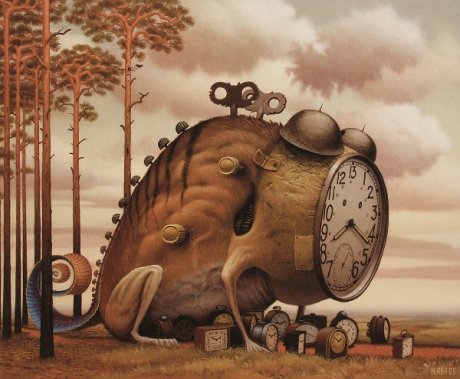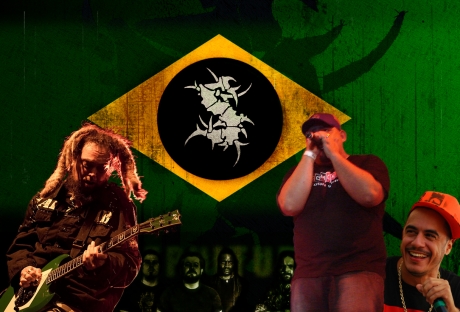Edward Burtynsky and manufactured landscapes: don’t say I didn’t talk about games August 12, 2010
Posted by Cesar in thinking me.Tags: edward burtynsky, industrialization, manufactured landscapes, photography, sustainability
add a comment
First and foremost, the most urgent: if you are near St. John’s, run to The Rooms and see Burtynsky’s photography exibition. It is fenomenal and will end August 15th. I’m serious, don’t miss it.
Yesterday I was there with Mary’s parents, they came to visit us here in St. John’s. I was not aware of the exhibit at all and, when I saw it, my jaw dropped. His work is amazing.
So after the initial impact, I started really contemplating the pictures and couldn’t stop looking. I got home, googled Burtynsky and my respect for him grew even more. Edward Burtynsky is a Canadian photographer who, at some point, decided to dedicate his career and I dare say his life to what he calls manufactured landscapes: landscapes that display in dramatic fashion the impact of mankind and heavy industrialization on our planet.
The most amazing thing about his work is that the images are gorgeous, unbelievably beautiful, but they portray very sad, disturbing, horrifying sceneries we conceived ourselves. These mixed feelings are in all of his work. And the photographs are so big, taken with such wide lenses, so crisp, that every one of them has multiple small details; nuances that make you think more and more.
But this is obviously more than a simple work of art. It is a meaningful way to remind people of what we are doing to our planet. And if you know me, you know I’m not much of a green talker. But this guy really reached me, that’s how powerful his work is. His pictures are used by worldchanging.com and others to impact everyone the same way they impacted me, and inspire mankind to start thinking (and acting!) about sustainability. It sure is inspiring.
For his work, in 2005 Burtynsky won the TED Prize. There are many TED talks with him (like this one) and, afaik, they are all worth watching.
I went to his website and put some of my favorites here on the blog. Not because they are hard to find, but just so I can look at them and remember them often.
Now I want to suggest you click this link to the very first picture of the gallery so you can see it full size. Done it? Now tell me: is the world of Fallout 3 that far away? Don’t those pictures remind you of the Wasteland and Megaton?
Did you notice? I told you I would talk about games.
See you space cowboys…
Video games and time: eternal brief moments August 6, 2010
Posted by Cesar in gaming me.Tags: chess, company of heroes, games, history, monopoly, poker, starcraft ii, time, video games
6 comments

Let me propose an exercise: think of games that have been around for a very long time.
If you thought of any computer game you didn’t think big enough. The first versions of Monopoly date to the beginning of the 20th century, when Lizzie Magie created a game to explain the downside of economical monopolies. It was published in 1924 as The Landlord’s Game. Charles Darrow’s variation, the one we know as Monopoly, was published in 1930.
Want to take it one step further? Poker can be traced back to the 15th century in Germany. Old versions of the game were played with 20 cards, the english 52 cards deck was introduced “only” in the 19th century. And if you think “new” variations are recent, the never so popular Texas hold’em dates to the beginning of the 20th century, more than a hundred years old.
Not old enough? Let’s talk about chess. The history of chess is huge and its precursors have been around for 1500 years. We can trace it back to 6th century India! And even the “modern” version, conceived in Europe and played across the globe to this day, has been around since the 15th century.
I could continue the list for a while. Olympic games are way older than chess. And I’m sure kids have been playing hide-and-seek since the beginning of mankind. But I digress, after all playing is part of who we are. So I will stop with chess for now and ask the big question: why is chess a secular game and video games have so short life spans?
When I initially thought about the subject, the first thing that popped into my head was depth: chess is a deep game, with millions of alternatives. No match is ever the same. It is probably true that a shallow game would have a short life, but video games history and theory defy the idea: since the games industry inception, games have been evolving pretty fast and as games evolve and grow more and more complex, the time people spend with them paradoxically gets smaller and smaller.
Look at the Atari generation: River Raid was played for a very long time. Then Nintendo came and we played Super Mario Bros for ages. In the Sega Genesis I played Sonic from the day I got it until I finally stopped using the platform. Even the concept of old games was fuzzy: we didn’t care if the game was from 1 or 2 years ago, we just played it.
But our games evolved and nowadays a game’s lifespan is much shorter (even though there are exceptions). For how long did you play Metal Gear Solid? What about Bioshock?
Someone might argue that, like I said before, Metal Gear Solid and Bioshock are shallow games. It is true, but not in a bad way. Some modern games are way more story driven. In old games, the goal was always to achieve the highest score possible. Some of them never ended and would loop back to the beginning so you could continue playing. When a game is too story driven, like Bioshock, it loses replay value. Of course you can play again with variances. But after 2 or 3 times, you got everything you could from it, unless you feel nostalgic afterward (like it happens with movies and books after all).
What really keeps a game alive is competition. We continue playing to beat the ever changing AI, a friend or ourselves, in score based games. So, in order to survive, a game needs to be entertaining, competitive and deep. And then I ask: how long did you play Modern Warfare 1? What about Company of Heroes (the best ranked strategy game at gamerankings.com)? Isn’t Company of Heroes deep enough? I’m sure it is.
So I was thinking about that. It is a bit sad that great games last so little, it feels like the cultural value of the game gets much smaller. I played Monopoly when I was a kid. My father taught me how to play chess. Yet somehow I don’t think I’ll be teaching my kids how to play Company of Heroes.
I think games are doomed with the curse of sequels. Be them direct sequels or not, the games industry is always recreating games. And the new ones replace the old inside the DVD drive. I stopped playing Modern Warfare 1 to play Modern Warfare 2. And stopped playing Modern Warfare 2 to play Bad Company 2.
The timing for this post is no coincidence. Last week Starcraft II, the sequel to the best RTS ever (IMHO), finally came out. Starcraft was a bastion for video game resilience: the classic from 1998 continued being played for 12 years without a sequel (just the Brood Wars expansion shortly after the original release), it became a national sport in South Korea. Is it probably just as complex as chess or even more. But its legion of players was getting smaller, the game surrounded by newer, better looking alternatives.
Last week, when reviewers started writing their impressions on the new game, probably the highest point of PC gaming in 2010, they mentioned innovations and improvements. And while I’m thrilled to see the sequel and craving to play it, I’m also a bit frustrated. It is sad to see a great game, that lasted 12 years, get a killing sequel. Starcraft was already loosing ground, even though many kept playing it even when Warcraft III came along. But I’m afraid it won’t resist a direct sequel. The old gives space to the new.
I’ll finish talking about the moments of joy games provide during their brief lives again. The current generation of players probably won’t teach the new one how to play Starcraft, not even Starcraft II. But while the games go back to the shelves, the genres continue alive and well.
In the constantly reinvented games industry, there’s no space for secular games, but there’s space for secular icons and concepts. The RTS genre won’t die. Nor will FPSs. And because the concepts remain the same, that’s what we’ll pass to the next generation, that’s the legacy of video games to the future.
And I’m sure Mario will be there too. That’s gotta count for something.
See you space cowboys…















